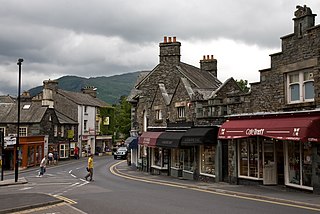
Ambleside is a town and civil parish in Westmorland and Furness, Cumbria, England, The town was historically in Westmorland. Located in the Lake District National Park, the town sits at the head of Windermere, England's largest natural lake. In 2020 it had an estimated population of 2596.

The New Haven Green is a 16-acre (65,000 m2) privately owned park and recreation area located in the downtown district of the city of New Haven, Connecticut. It comprises the central square of the nine-square settlement plan of the original Puritan colonists in New Haven, and was designed and surveyed by colonist John Brockett. Today the Green is bordered by the modern paved roads of College, Chapel, Church, and Elm streets. Temple Street bisects the Green into upper (northwest) and lower (southeast) halves.

Rydal Mount is a house in the small village of Rydal, near Ambleside in the English Lake District. It is best known as the home of the poet William Wordsworth from 1813 to his death in 1850. It is currently operated as a writer's home museum.
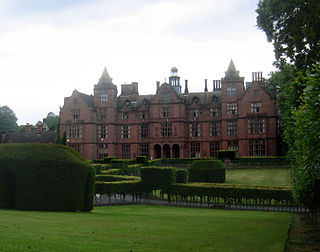
Hewell Grange is a former country house in Tardebigge, Worcestershire, England. "One of the most important late 19th century country houses in England", the mansion was built between 1884 and 1891 by George Frederick Bodley and Thomas Garner for Robert Windsor-Clive, later first Earl of Plymouth. Constructed in the Jacobethan style, it was "perhaps the last Victorian prodigy house". After the Second World War, the third earl sold the Hewell estate to the Crown and it was redeveloped as a prison. The mansion was used to house young offenders, and later low-risk prisoners, while adult prisons were built in the grounds. The site was subsequently consolidated as HM Prison Hewell. In 2019, the Ministry of Justice announced the closure of the Category D open prison housed in Hewell Grange, after a highly critical report by Her Majesty's Inspectorate of Prisons.
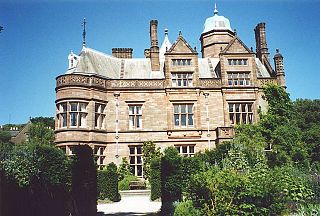
Holker Hall is a privately owned country house located about 2 km to the southwest of the village of Cartmel in the ceremonial county of Cumbria and historic county of Lancashire, England. It is "the grandest [building] of its date in Lancashire ...by the best architects then living in the county." The building dates from the 16th century, with alterations, additions, and rebuilding in the 18th and 19th centuries. The 19th century rebuilding was by George Webster in Jacobean Revival style and subsequent renovations were by E. G. Paley. Hubert Austin had a joint practice with Paley by the 1870s and they both rebuilt the west wing after it was destroyed by a major fire in 1871, only a decade after Paley's previous work on the structure. The fire also destroyed a number of notable artworks. Holker Hall is Paley and Austin's "most important country house commission." The architectural historian Nikolaus Pevsner expressed the opinion that the west wing is the "outstanding domestic work" of Paley and Austin. In 1970 the hall itself, together with its terrace wall, were designated Grade II* Listed buildings. The house stands in an estate of about 80 hectares, and is surrounded by formal gardens, parkland and woodland. Within the grounds are six structures listed at Grade II.

Wordsworth House is a Georgian townhouse situated in Cockermouth, Cumbria, England, and in the ownership of the National Trust. It was built in the mid-18th century. William Wordsworth was born in the house in 1770. The house is a Grade I listed building. It is open to the public as a writer's house museum from March to October each year.

Levens Hall is a manor house in the Kent valley, near the village of Levens and 5 miles (9 km) south of Kendal in Cumbria, Northern England.
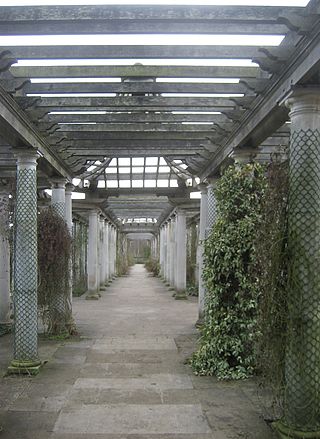
Thomas Hayton Mawson, known as T. H. Mawson, was a British garden designer, landscape architect, and town planner.

Rydal Hall is a large detached house on the outskirts of the village of Rydal, Cumbria, in the English Lake District. It has an early nineteenth-century front facade, but includes some earlier fabric.

Hawkshead Grammar School in Hawkshead, Cumbria, England was founded in 1585 by Archbishop Edwin Sandys, the incumbent Archbishop of York, whose family came from the Hawkshead area. He petitioned Queen Elizabeth I for a charter to set up the school and endowed it will sufficient land and property for the education to be free, and for many years it was known as 'The Free Grammar School of Hawkshead'. The early School taught Latin, Greek and sciences, including arithmetic and geometry. At its peak in 1750-1800, it had a very good reputation for teaching Maths and getting boys into Cambridge, and attracted pupils from across the North of England and southern Scotland. Although the School closed in 1909, the building functions today as Hawkshead Grammar School Museum and is open to the public.

Blackwell is a large house in the English Lake District, designed in the Arts and Crafts style by Baillie Scott. It was built in 1898–1900, as a holiday home for Sir Edward Holt, a wealthy Manchester brewer. It is near the town of Bowness-on-Windermere with views looking over Windermere and across to the Coniston Fells.
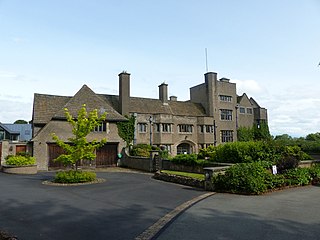
Tirley Garth is a large country house some 2.5 miles (4 km) to the north of Tarporley, Cheshire, England. The house together with its entrance courtyard walls are recorded in the National Heritage List for England as a designated Grade II* listed building.

Hutton in the Forest is a Grade I listed country house near the village of Skelton in the historic county of Cumberland, which now forms part of the modern county of Cumbria, England. It has belonged to the Fletcher-Vane family, latterly the Barons Inglewood, since 1605.
Edward Prentice Mawson was the eldest of the nine children of Thomas Hayton Mawson, and, like his father a British garden designer, landscape architect, and town planner.

Hanley Park is an urban park in Stoke-on-Trent, England. Officially opened on 20 June 1897, it occupies about 63 acres (25 ha) of land. The park was developed by the town of Hanley over a period of five years and cost approximately £70,000. It has been described as a good example of a late Victorian municipal park, and is listed Grade II* in Historic England's Register of Parks and Gardens.
Barrow Park is a 45-acre public park in Barrow-in-Furness, Cumbria, England. It is located entirely within the Parkside ward, to which the park lends its name, bound by Abbey Road, Park Drive, Greengate Street and Park Avenue. Barrow Park was designed by Thomas Mawson in 1908 and was constructed in stages over the following two decades. Originally sited on the outskirts of Barrow, the park is now more or less central due to rapid growth of the town northwards during the early 20th century. It is designated by Historic England as Grade II on the Register of Historic Parks and Gardens.
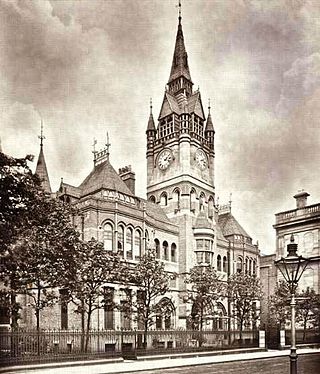
Richard Knill Freeman was a British architect who began his career at Derby and moved to Bolton, Lancashire in the late 1860s. His work, in Victorian Gothic style and typically recalling the Decorated Period of later medieval architecture, can be seen in several cities and towns across the north of England. He worked in total on about 140 buildings, of which about half survive in some form.
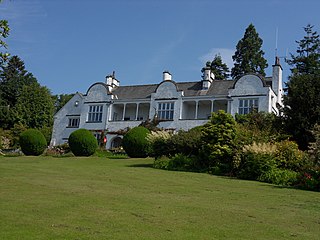
The Brockhole Lake District Visitor Centre, also known as the Brockhole National Park Visitor Centre, is a visitor centre and tourist attraction managed by the Lake District National Park Authority. It is situated on the shore of Lake Windermere, roughly equidistant between the towns of Bowness-on-Windermere and Ambleside. It includes the Brockhole house and 30 acres (12 ha) of grounds, including 10 acres (4.0 ha) of formal gardens and an adventure playground. The centre organises a number of activities, including orienteering, kayaking and open water swimming, as well as regular exhibitions.
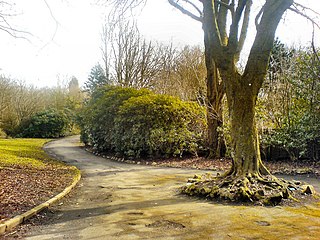
Falinge Park is a Grade II listed public park located in Rochdale, Greater Manchester. Opened to the public in 1906, it lies in the historic grounds of the 18th century Falinge Hall.

Burslem Park is a public park in Burslem, Stoke-on-Trent, Staffordshire, England. It was opened in 1894, and is essentially unchanged from the original layout. It is listed Grade II* in Historic England's Register of Parks and Gardens.




















